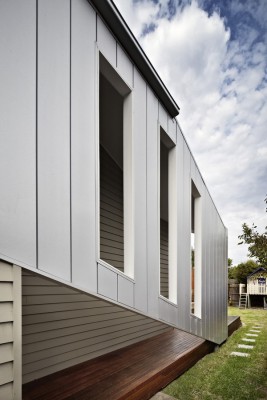Blurred House, Melbourne Residence, Australian Architecture, Victoria Home Images
Blurred House
Contemporary Victoria Home Extension, New Australian Property – design by Bild Architecture
25 Mar 2015
Blurred House in Melbourne
Design: Bild Architecture
Location: Melbourne, Victoria, Australia
The first in a series of studies into the adaptation of vernacular Australian suburban typologies, Blurred House is a major renovation and extension to an original 1930’s Californian bungalow in Melbourne’s inner-north.
Reacting to the established convention of residential extension which prescribes a jarring juxtaposition of existing ‘old’ and introduced ‘new’ architectural elements; the ‘Blurred House’ offers an alternative proposition; that of a blurring between ‘old’ and ‘new’ to produce a grafted condition.
Viewed from the street, the house appears largely unchanged, with a small clerestory window the only hint of reconfiguration. Both internally and externally; moving through the house, new materials, spatial characters and formal language is progressively introduced. By the time of arrival in the back yard, the house has evolved into a different building; no longer recognizable from its original starting point; an architectural ‘rabbit in a hat’.
The existing building, as was common when it was constructed, had very limited connections the outside and was quite dark inside. The original house was partially demolished, in fact the rear half of the house was leveled to the sub-floor and then completely rebuilt. This allowed the freedom to produce a series of very contemporary spaces at the rear of the house that provides very strong visual and spatial connection to the garden and pool at the rear of the property.
Reflecting the formal strategy of transition, rooms at the front of the property are left largely unadulterated, remaining more enclosed. On the other hand, living spaces to the rear are progressively more open and interconnected embracing the garden and pool areas. These varied spaces respond to different ‘modes’ of living, with different volumetric, acoustic, and light qualities. Whilst these spaces are linked to a greater or lesser degree, they are not ‘open plan’ in a conventional sense, rather configured in a more nuanced distribution of distinct spaces and functions.
The interior spaces of the house are highly varied, allowing for the family to use the building in a variety of ways during the year and as the children get older. The design provides a series of different living spaces; formal/informal, open with strong connections to the outside vs. enclosed and cozy, allowing us to use the house in different ways though-out the year and over time. The design also provided for a self-contained a teenagers’ retreat, so that as the children grow they can gain privacy and independence while staying in the family home.
The key conceptual strategy for the project was the grafting of the new/additional building elements; while the new elements of the building are very contemporary, they use the geometry of the existing building as a base. For example, the roof forms of the new section of the house connect into the existing roof, and use its geometry and formal language (valleys, hips and gables) but in radially new ways to enclose the volumes of the new portions of the building. All of these new elements retain the roof angle and materials of the original building so that they appear distinct yet connected to the original.
Many of the house’s original materials were retained and re-used through the building; including the Baltic-pine flooring (originally imported into Australia in the 1920’s) used throughout the ground level, was restored and re-laid in some areas. The walls and ceilings were consciously left white, as a neutral backdrop to the clients expanding art collection. The bathrooms used contemporary materials and fittings, however referenced the period detailing of the original house, with contrasting boarder inlays in the floor and use of hexagon mosaics.
The house consciously prioritizes environmental performance. The design utilizes passive solar design techniques; the large glazed wall is orientated due East, to maximize daylight penetration in the mornings, while the prominent eaves shield the interior from direct sunshine during the heat of the day and from the strong afternoon sun in the afternoon. Although the building has significantly increase in size, the passive solar design (in combination with upgrading the insulation) has led to a significant reduction in the building’s energy use and reliance of heating and cooling throughout the year.
A graft of old and new, oscillating between the past and present, the Blurred House sits comfortably in the street scape as something familiar yet alien. Gradually transitioning from the vernacular to the contemporary, the division of the original and the addition is deliberately ambiguous, producing a unique formal and visual language.
Blurred House in Melbourne – Building Information
Project Director: Ben Milbourne
Project Team: Haslet Grounds, Alison Stout, Edmund Carter, John Doyle
Completion: 2011
Photography: TM Photo
Blurred House in Melbourne images / information from Bild Architecture
Location: Melbourne, Victoria, Australia
Architecture in Melbourne
Melbourne Architecture Designs – chronological list
The Ceres Gable House, Geelong, Victoria
Architects: Tecture

photo : Peter Clarke Photography
New House in Geelong
Richmond Terrace
Architects: Robert Nichol & sons

photograph : Lillie thompson
Richmond Terrace Property
Mash House
Design: Andrew Maynard Architects
Letterbox House
Design: McBride Charles Ryan Architects
Website: Beaumaris
Cloud House North Fitzroy
Architect: McBride Charles Ryan
Comments / photos for Blurred House in Melbourne page welcome
Website: Bild Architecture
Website: TM Photo














